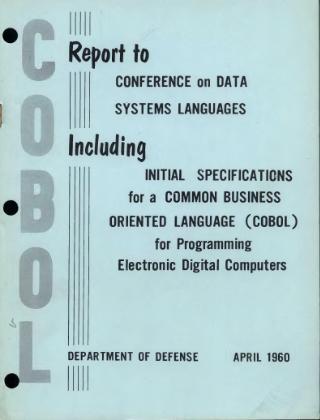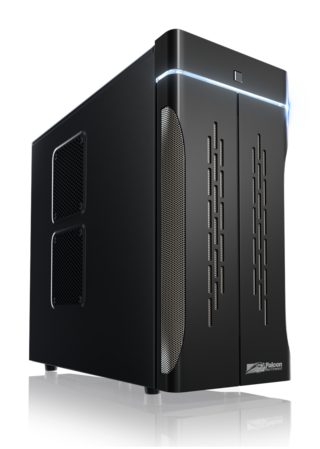Related Research Articles

COBOL is a compiled English-like computer programming language designed for business use. It is an imperative, procedural, and, since 2002, object-oriented language. COBOL is primarily used in business, finance, and administrative systems for companies and governments. COBOL is still widely used in applications deployed on mainframe computers, such as large-scale batch and transaction processing jobs. Many large financial institutions were developing new systems in the language as late as 2006, but most programming in COBOL today is purely to maintain existing applications. Programs are being moved to new platforms, rewritten in modern languages, or replaced with other software.

Fortran is a third generation, compiled, imperative programming language that is especially suited to numeric computation and scientific computing.

The GNU Compiler Collection (GCC) is a collection of compilers from the GNU Project that support various programming languages, hardware architectures and operating systems. The Free Software Foundation (FSF) distributes GCC as free software under the GNU General Public License. GCC is a key component of the GNU toolchain which is used for most projects related to GNU and the Linux kernel. With roughly 15 million lines of code in 2019, GCC is one of the largest free programs in existence. It has played an important role in the growth of free software, as both a tool and an example.

Java is a high-level, class-based, object-oriented programming language that is designed to have as few implementation dependencies as possible. It is a general-purpose programming language intended to let programmers write once, run anywhere (WORA), meaning that compiled Java code can run on all platforms that support Java without the need to recompile. Java applications are typically compiled to bytecode that can run on any Java virtual machine (JVM) regardless of the underlying computer architecture. The syntax of Java is similar to C and C++, but has fewer low-level facilities than either of them. The Java runtime provides dynamic capabilities that are typically not available in traditional compiled languages.
A programming paradigm is a relatively high-level way to conceptualize and structure the implementation of a computer program. A programming language can be classified as supporting one or more paradigms.
Blogger is an American online content management system founded in 1999 which enables its users to write blogs with time-stamped entries. Pyra Labs developed it before being acquired by Google in 2003. Google hosts the blogs, which can be accessed through a subdomain of blogspot.com. Blogs can also be accessed from a user-owned custom domain by using DNS facilities to direct a domain to Google's servers. A user can have up to 100 blogs or websites per account.

The history of programming languages spans from documentation of early mechanical computers to modern tools for software development. Early programming languages were highly specialized, relying on mathematical notation and similarly obscure syntax. Throughout the 20th century, research in compiler theory led to the creation of high-level programming languages, which use a more accessible syntax to communicate instructions.

The Wire is a British music magazine publishing out of London, which has been issued monthly in print since 1982. Its website launched in 1997, and an online archive of its entire back catalog became available to subscribers in 2013. Since 1985, the magazine's annual year-in-review issue, Rewind, has named an album or release of the year based on critics' ballots.
IBM LAN Server is a discontinued network operating system introduced by International Business Machines (IBM) in 1988. LAN Server started as a close cousin of Microsoft's LAN Manager and first shipped in early 1988. It was originally designed to run on top of Operating System/2 (OS/2) Extended Edition. The network client was called IBM LAN Requester and was included with OS/2 EE 1.1 by default. Here the short term LAN Server refers to the IBM OS/2 LAN Server product. There were also LAN Server products for other operating systems, notably AIX—now called Fast Connect—and OS/400.

In personal computing, a tower unit, or simply a tower, is a form factor of desktop computer case whose height is much greater than its width, thus having the appearance of an upstanding tower block, as opposed to a traditional "pizza box" computer case whose width is greater than its height and appears lying flat.

Zenith Data Systems Corporation (ZDS) was an American computer systems manufacturing company active from 1979 to 1996. It was originally a division of the Zenith Radio Company, after they had purchased the Heath Company and, by extension, their Heathkit line of electronic kits and kit microcomputers, from Schlumberger in October 1979. ZDS originally operated from Heath's own headquarters in St. Joseph, Michigan. By the time Zenith acquired Heathkit, their H8 kit computer already had an installed fanbase of scientific engineers and computing enthusiasts. ZDS' first offerings were merely preassembled versions of existing Heathkit computers, but within a few years, the company began selling bespoke systems, including the Z-100, which was a hybrid 8085- and 8088-based computer capable of running both CP/M and MS-DOS.

The Satellite Pro is a line of laptop computers designed and manufactured by Dynabook Inc. of Japan, which was formerly Toshiba's computer subsidiary. The Satellite Pro is currently positioned between their consumer E series and their business Tecra series of products.
The following tables provide a comparison of numerical analysis software.

OmniBook is a line of laptops originally made by Hewlett-Packard and currently sold by HP Inc., the 2015 successor to the original Hewlett-Packard. It was first introduced in 1993 as a line of business-oriented laptops and subnotebooks and was originally discontinued in 2002 following the acquisition of Compaq by Hewlett-Packard, with the Compaq Presario, HP Compaq, and HP Pavilion laptops succeeding the OmniBook line.

Object-oriented programming (OOP) is a programming paradigm based on the concept of objects, which can contain data and code: data in the form of fields, and code in the form of procedures. In OOP, computer programs are designed by making them out of objects that interact with one another.

An application programming interface (API) is a way for two or more computer programs or components to communicate with each other. It is a type of software interface, offering a service to other pieces of software. A document or standard that describes how to build or use such a connection or interface is called an API specification. A computer system that meets this standard is said to implement or expose an API. The term API may refer either to the specification or to the implementation. Whereas a system's user interface dictates how its end-users interact with the system in question, its API dictates how to write code that takes advantage of that system's capabilities.

Music & Media was a pan-European magazine for radio, music and entertainment. It was published for the first time in 1984 as Eurotipsheet, but in 1986 it changed name to Music & Media. It was originally based in Amsterdam, but later moved to London. The magazine focused specifically on radio, TV, music, charts and related areas of entertainment such as music festivals and events. Music & Media ceased in August 2003. Music & Media was the sister publication of Billboard magazine.

Canon Computer Systems, Inc. (CCSI), sometimes shortened to Canon Computer, was an American subsidiary of Canon Inc. formed in 1992 to develop and market the parent company's personal computers and workstations. The subsidiary also assumed the responsibility of marketing Canon's printers and photocopiers, which were formerly sold by other Canon divisions. It went defunct in January 2001.
References
- ↑ Staff writer (April 1989). "The NeXT Fortran". Journal of Object-oriented Programming. 2 (4). SIGS Publications: 88 – via Google Books.
- ↑ Staff writer (June 24, 1991). "Upgrades". InfoWorld. 13 (25). IDG Publications: 19 – via Google Books.
- ↑ "Fortran 2003– Last Working Draft". Gnu.Org. Retrieved May 10, 2014.
- ↑ "WG5 Completes Processing Fortran 2003 and the TR". nag.co.uk. May 14, 2004. Archived from the original on August 5, 2004. Retrieved April 3, 2023.. It may also be downloaded as a PDF file at "The New Features of Fortran 2003" (PDF). Archived (PDF) from the original on January 15, 2018. Retrieved April 3, 2023.